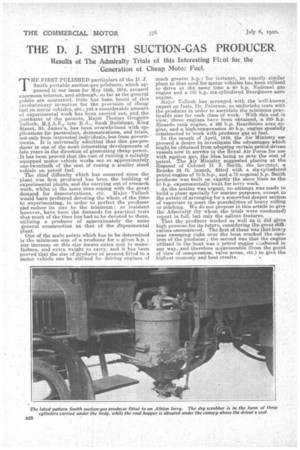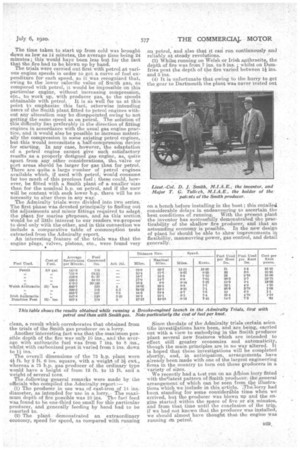THE D. J. SMITH SUCTION-GAS PRODUCER.
Page 22

Page 23

If you've noticed an error in this article please click here to report it so we can fix it.
Results of The Admiralty Trials of this Interesting Plant for. the Generation of Cheap Motor Fuel.
THE FIRST P [HASHED particulars of the D. J. Smith portable auction-gas prOducer, which appeared in our issue for May 15th, 1919, aroused enormous interest, and although, so far as the general public are concerned, little has been heard of this revolutionary invention for the. provision of cheap fuel on motor vehicles, etc., yet a considerable amount of experimental work has been carried out, and the purchaser of the patents, Major Thomas Gregoire M.I.A.E., late R.A. Bank Buildings, King Street, St. James's, has beer; overwhelmed with applications for particulars, demonstrations, and trials, not only from interested individuals, but from, governments. It is universally admitted that at this gas-producer is one of the most interesting-developments of late years in the direction of generating cheap power. . It has been proved that the cost of running a suitably equipped motor vehicle works out at aipproximately one-twentieth of the cost of runing a similar. sized vehicle on petrel fuel. The chief difficulty which has occurred since the plant was first produced has been the building of experimental plants, and the carrying out of research work, whilst at the same time coping with the great demand for demonstrations, etc. Major Tulloch would have preferred devoting the whole of the time to experimenting, in order to perfect the producer and reduce its size to the minimum ; so insistent however, have been the demands for praotical tests that much of the time has had to be devoted to these, utilizing a producer of approximately the same general construction as that of the lexperimental plant.
One of the main points which has to be determined is the minimum size of a producer for a, given h.p. ; any increase on this size means extra cost in manufacture, and extra weight to carry,. and it has been proved that the size of producer at. present fitted to a motor vehicle can be utilized for driving engines of much greater h.p.: for instance, an exactly similar plant to that used for motor vehicles has been utilized to drive at the same time a 40 h.p. National gas engine and a 100 h.p. six-cylindered. Beardmore aero engine.
Alajor Tulloch has arranged, with the well-known expert on fuels, Dr. Paterson, to undertake tests with the producer in order to ascertain the minimum practicable size for each class of work. With this end in view, three engines have been obtained, a 225 1.p. Ricardo tank engine, a 160 h.p. Beardmore acre engine, and a high-compression 40 h.p. engine specially constructed to work with producer gas as fuel.
In the month of April, 1919, the Air Ministry ex. pressed a, desire to investigate the advantages which might be obtained from adapting certain petrol-driven vessels now in servite in the Royal Air Force for use with suction gas, the idea being to save the cost of petrol. The Air Ministry suggested placing at the disposal of Colonel D. J. Smith, the inventor, a Brooke 35 ft. _launch, fitted with a six-cylindered petrol engine of 70 b.h.p., and a 75 nominal h.p. Smith producer was built on exactly the same lines as the 50 h.p. experimentally built for lorry work. As the matter was urgent, no attempt was made to build a, plant specially for marine purposes, except to the extent of arranging for a somewhat deeper section of vaporizer to meet the possibilities of heavy rolling or pitching. We do not propose in this article to give the AdmiraltS' (by whom the trials were conducted) report in full, hut only the salient features.
That the producer worked as well as it did gives high promise for its future, considering the great difficulties encountered. The first of these was that heavy seas sweeping right over the boat cracked the castiron of the producer ; the second was that the engine utilized in the boat was a petrol engine j'.ialtered in any way, and therefore init:avourable (from the point of view of compression, valve areas, etc.) to give the highest economy and best results.
The time taken to start tip from cold was brought down as low as 14 minutes, the average time being 24 minutes; this would haye been less but feu' the tact that the .fire had to be blown up by hand.
The trials were carried out first with petrol at various engine speeds in order to get a curve of fuel expenditure for each speed, as it was recognized that, owing to the lower calorific value of Smith gas, as compared with petrol, it would be impossible on this particular engine, without increasing compression, etc., to work up, with producer gas, to the speeds obtainable with: petrol. It is as well for us at this point to emphasize this fact, otherwise intending users of the Smith plant fitted to petrol engines without any alte cation may be disappointed owing to not getting the same speed as on petrol. The solution of this difficulty lies preferably in the direction of fitting engines in accordance with the usual gas engine practice, and it would also be possible to increase materially the compression in some existing petrol engines, but this -would necessitate a half-compression devjce for starting. In any case, however, the adaptation Of a petrol engine cannot give such satisfactory results as a properly designed gas: engine, as, quite apart from any other considerations, the, valve or port areas should be larger for gas than for petrol. There are quite a large number of petrol engines available which, if used with patrol, would consume far too much of this precious fuel ; these could, however, be fitted with a Smith plant ofa smaller size than for the nominal h.p. on petrol, and if the user will be content with such lower h.p. there will be no necessity to alter them in any way. The Admiralty trialswere, divided into two series.' The first phase was devoted principally to finding out the adjustimmits and minor fittings required to adapt the plant for marine Oil:poses, and as this. section, Would be of little interest to our readersewe.proposei to deal only with the other, and in tlais eonneetion we include a comparative table, of consumption tests extracted from the Admiralty report.
An interesting feature of :the trials was that the engine plugs, valves, pistons, etc., were found very clean, a res t which corroborates that obtained from the trials of the Smith gas producer on a lorry.
Another interesting fact was that the maximum possible depth of the fire was onl!y 10 ins., and the average with anthracite fuel was from 7 ins. to 8 ins., whilst with Carbonized peat it varied from 5 ins, down to l ins.
The overall dimensions of the 75 h.p. plant were 4i ft. by 2 ft. 6 ins. square, with a weight of .3icwt., whereas 'a 75 h.p. gas producer of the ordinary type would have a height of from 12 ft. to 15 ft and a wei lit of several tons.
e :following •general remarks were made by the officials -who :compiled the Admiralty report :—
(1) The producer in use was of cast-iron of 14 ins.diameter, as intended for use in a lorry.The maximum depth of fire possible was 10 ins. The fuel feed was found to he one-third too small for this particular producer, and generally feeding by hand had to be resorted to.
(2) The plant demonstrated an extraordinary economy, speed for speed, as compared with running on petrol, and also that it can run continuously and reliably at steady revolutions.
(3) Whilst running on Welsh or Irish anthracite, the depth of fire was from 7 ins. to 8 ins. e whilst on aimfries peat the depth of the fire varied between 3 ins. and 5 me.
(4) It is unfortunate that owing to the hurry to get the gear to Dartmouth the plant was never tested out on a bench before installing in the boat ; this entailed considerable delays in endeavouring to ascertain the best. conditions of running. With the present plant the inventor has successfully demonstrated the practicabitity of the shallow fire producer, and that an astounding economy is possible. In the new design of plant he' should be able to show improvements in manceuvring power, gas control, and detail generally.
Since the7date of the Admiralty trials certain scientific investigations have been, and are being, carried out with a -view to embodying in the Smith producer plant several new features which are intended to effect still greater economies and automaticity, though the main-principles are in noway ,altered. It is hoped that these investigations will be completed shortly, and, in anticipation, arrangements have already been made with one of the largest engineering firms in the country to turn out these Qrodueers in a variety of sizes.
We recently had a test run on an Arnion lorry fitted with thOlate.st pattern of Smith nroautier. Llie.general arrangement of which can be seen from the illustrations which we include in this article. T.Theaorry had been, standing for some considergble time. when we arrived, but the producer was blown up and the engine started within the space of five or six minutes, and from that time until the conclusion of the trip, if we had not known that the producer was installed, we should almost have thought that the engine was running an petrol.




























